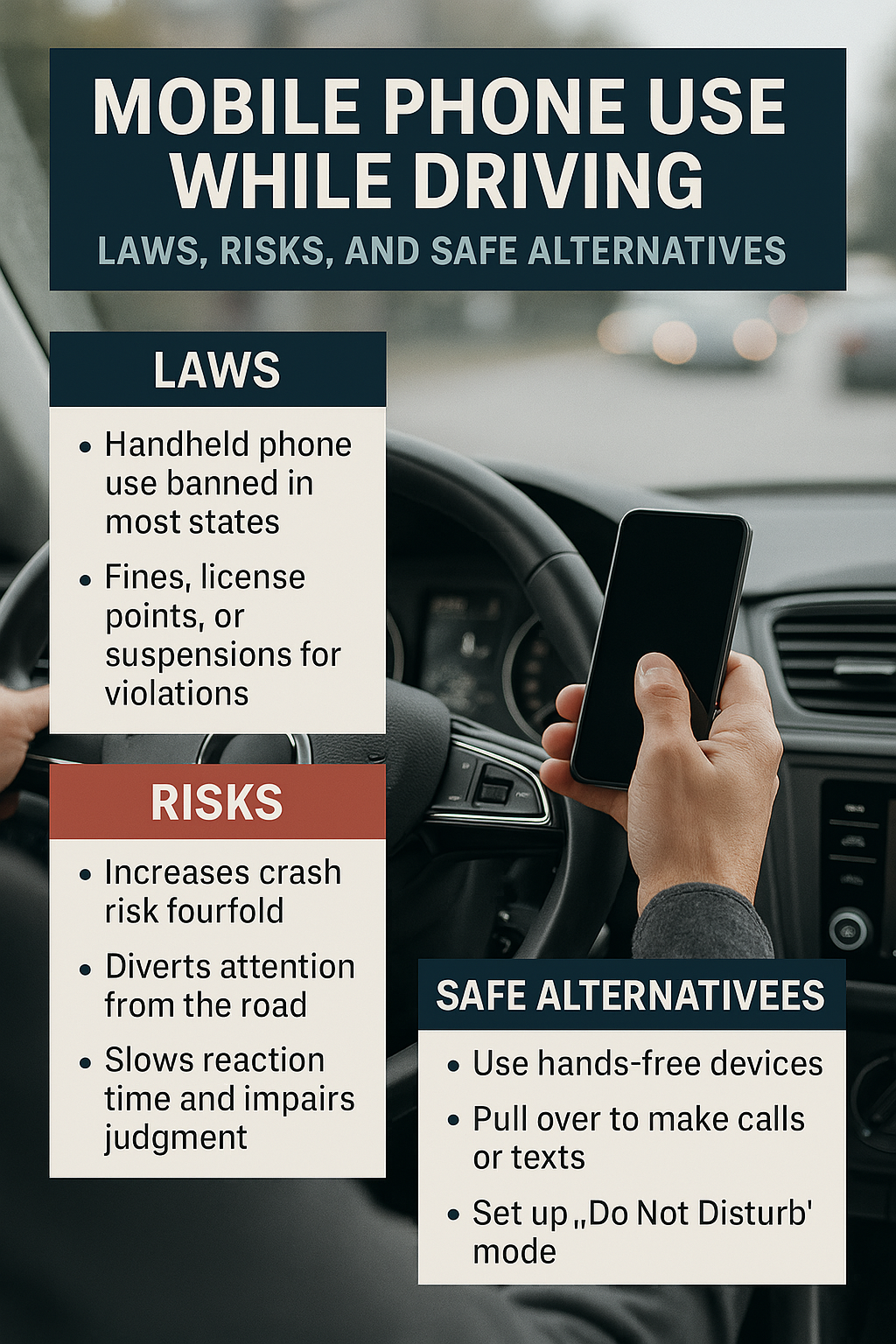Introduction
Mobile phone use while driving is a modern epidemic that significantly increases the risk of road accidents. Despite widespread awareness, many drivers still reach for their phones while operating a vehicle, thinking a quick text or call won’t do any harm, However, these distractions can lead to devastating consequences, both legally and personally, In this article, we’ll explore the extent of the issue, current legal measures, the underlying risks, and most importantly, the practical steps you can take to reduce mobile distraction while driving.
🗂️ Table of Contents
1- The Global Problem of Mobile Phone Use While Driving
According to the World Health Organization (WHO), distracted driving primarily caused by mobile phone use is a leading contributor to road crashes worldwide, Drivers are four times more likely to be involved in a collision when using a mobile phone, regardless of whether it’s hands-free or handheld, In countries like the United States, texting while driving causes more than 400,000 injuries each year, This is not just a youth problem; adults of all ages are guilty of using phones behind the wheel, The problem lies not only in usage but also in perception most people overestimate their ability to multitask safely.
2- Key Laws Regulating Mobile Phone Use
In response to the growing threat, many countries have enacted legislation aimed at reducing mobile phone use while driving, For instance, in the United Kingdom, drivers can face up to six penalty points and a £200 fine for using a handheld phone, In the U.S. laws vary by state, but texting and driving is banned almost nationwide, European countries have taken similar steps, with penalties ranging from on-the-spot fines to license suspension, Despite this, enforcement remains a challenge, In some regions, penalties are poorly enforced or inconsistently applied, making it difficult to deter habitual offenders.
3- The Hidden Psychological and Physical Risks
Many drivers believe that using a mobile phone while driving especially hands-free is safe, However, research shows that cognitive distraction can be just as dangerous as physical distraction, When you’re mentally engaged in a conversation or focused on your screen, your brain processes less visual information from your surroundings, This phenomenon, known as ‘inattentional blindness,’ means a driver may miss obvious hazards like pedestrians or traffic signals, Moreover, even a momentary lapse in concentration can delay reaction times significantly, which in turn increases stopping distances and reduces the ability to avoid accidents.
4- Real-World Consequences: Accidents and Legal Penalties

The consequences of using a mobile phone while driving can be catastrophic, Real-world cases abound where simple distractions have resulted in fatal crashes, For example, a few seconds spent typing a message has led to devastating pileups on highways or fatal collisions in urban areas, Apart from the emotional trauma and potential injury or death, drivers caught using phones can face severe legal penalties, In many jurisdictions, drivers involved in phone-related accidents can be charged with criminal negligence, face large fines, or even serve jail time, Additionally, insurance premiums can skyrocket, and a conviction can leave a permanent mark on one’s driving record, affecting employment and travel opportunities.
5- Safe Alternatives to Stay Connected
While it’s best to avoid using your phone at all while driving, there are safer alternatives for those who must remain connected, Modern smartphones and vehicles now include ‘Do Not Disturb While Driving’ features that automatically silence notifications, Apps like Android Auto and Apple CarPlay offer voice-command capabilities so you can make calls, dictate messages, or navigate without touching the screen, Bluetooth headsets or in-car speaker systems also reduce the need for physical contact with your phone, Another tip is to plan your communication in advance make calls before you hit the road and inform friends or colleagues you’ll be unavailable while driving.
6- Tips to Build Better Habits Behind the Wheel
Building better habits takes consistency and self-awareness, The first step is recognizing how often you reach for your phone while driving, Next, place your phone in a spot where it’s hard to access, such as the glove box or trunk, You can also use mobile apps that block calls and texts while the car is moving, Set an automatic reply to incoming messages that tells contacts you’re driving and will respond later, Involve your passengers too they can handle urgent calls or directions if needed, Eventually, avoiding mobile phone use while driving will become a natural part of your routine.
Conclusion
Using a mobile phone while driving may seem harmless in the moment, but the risks are real and often irreversible, From increased accident risk to legal consequences and emotional trauma, the dangers far outweigh the convenience, Understanding your local laws, being aware of the psychological effects, and actively working to change your habits can help you become a safer, more responsible driver, Let’s all do our part to make the roads safer one distraction-free trip at a time.
📌 Internal Link :
🌐 External Source :

